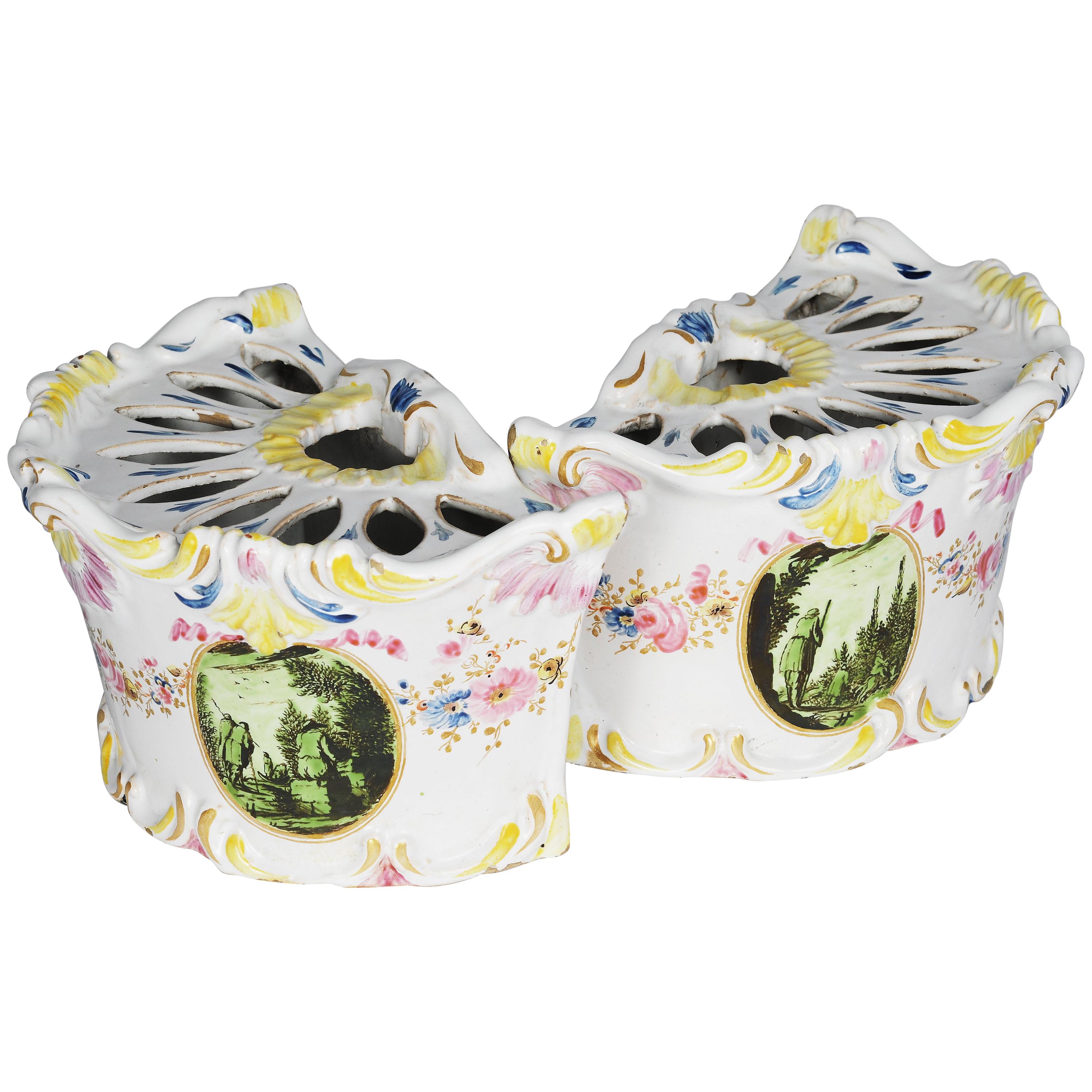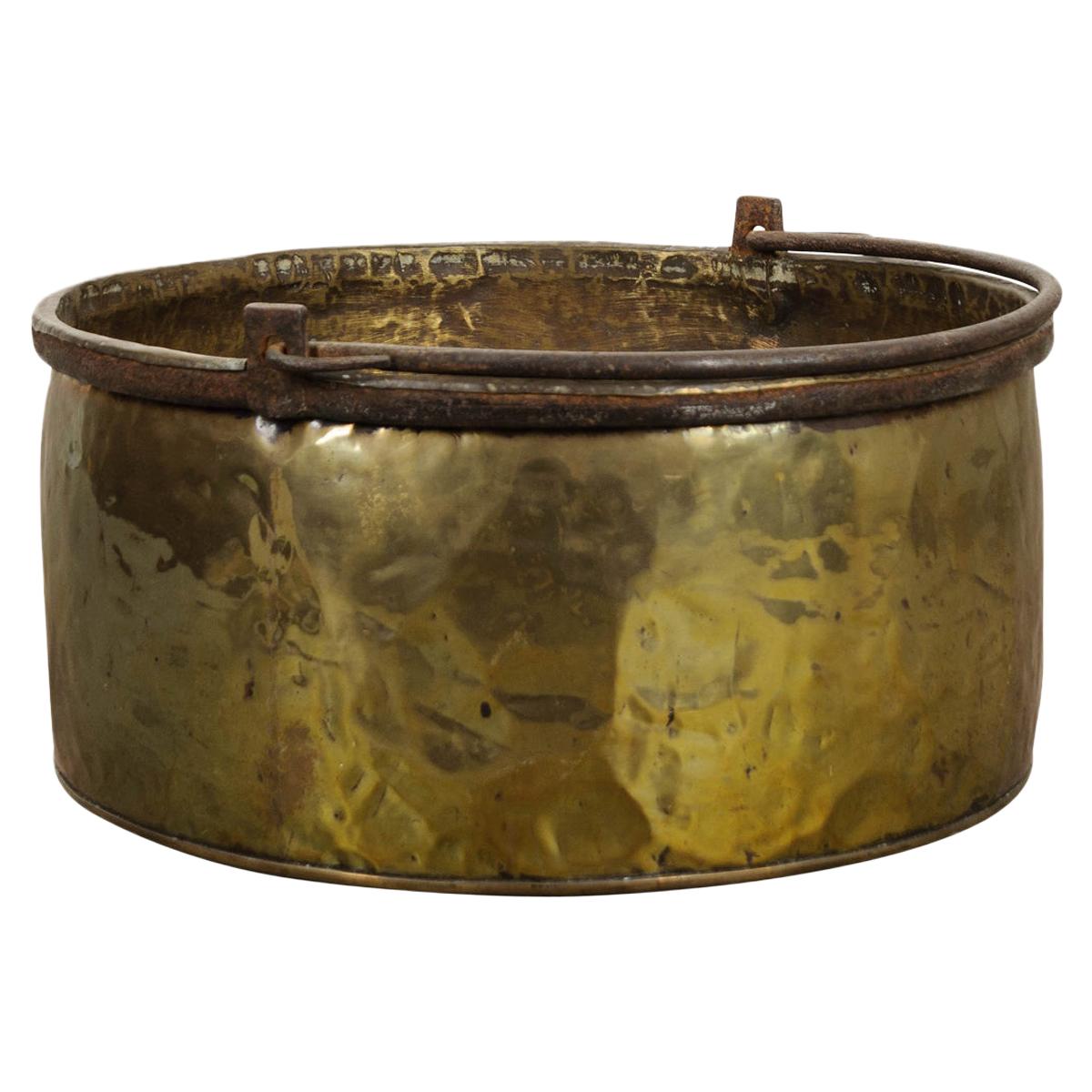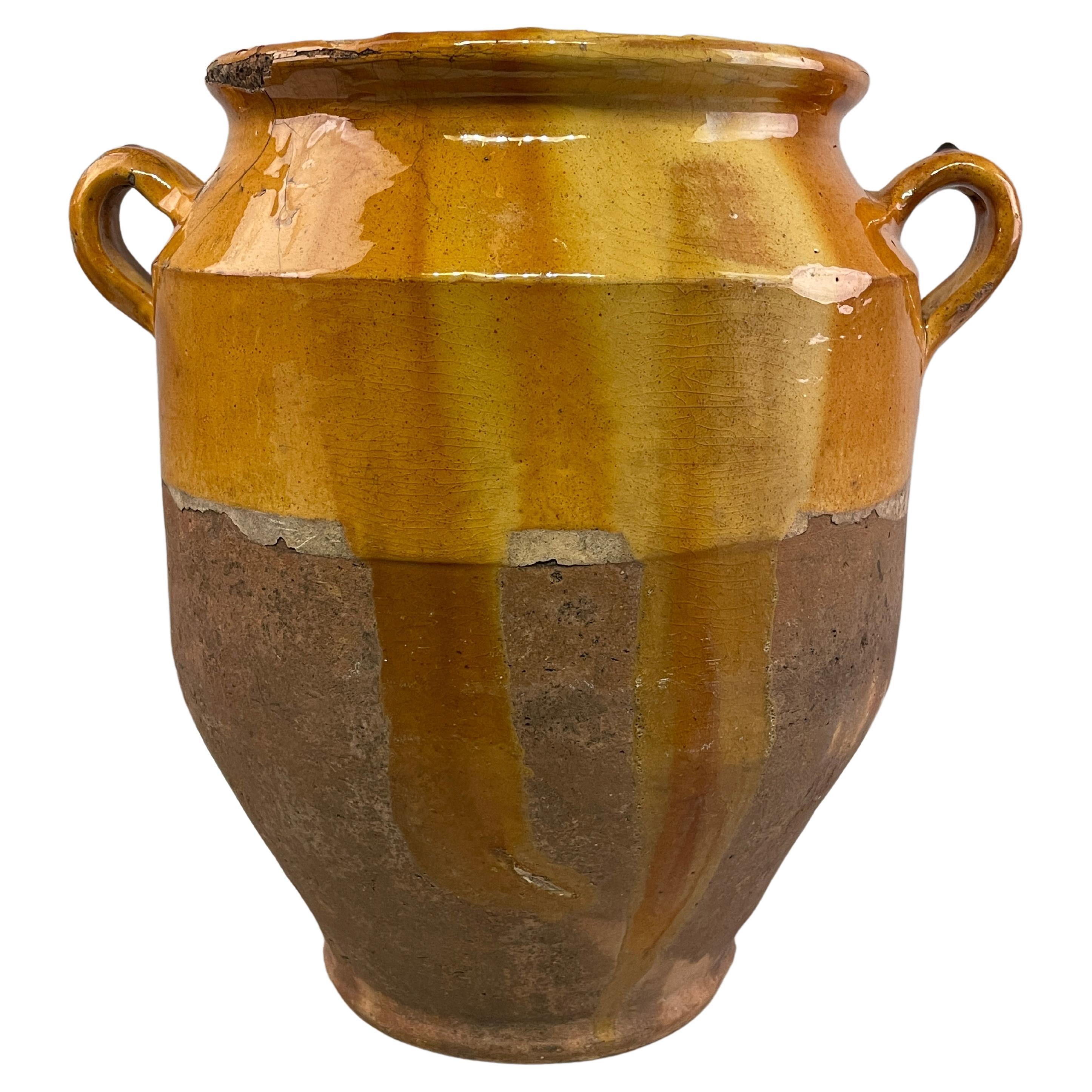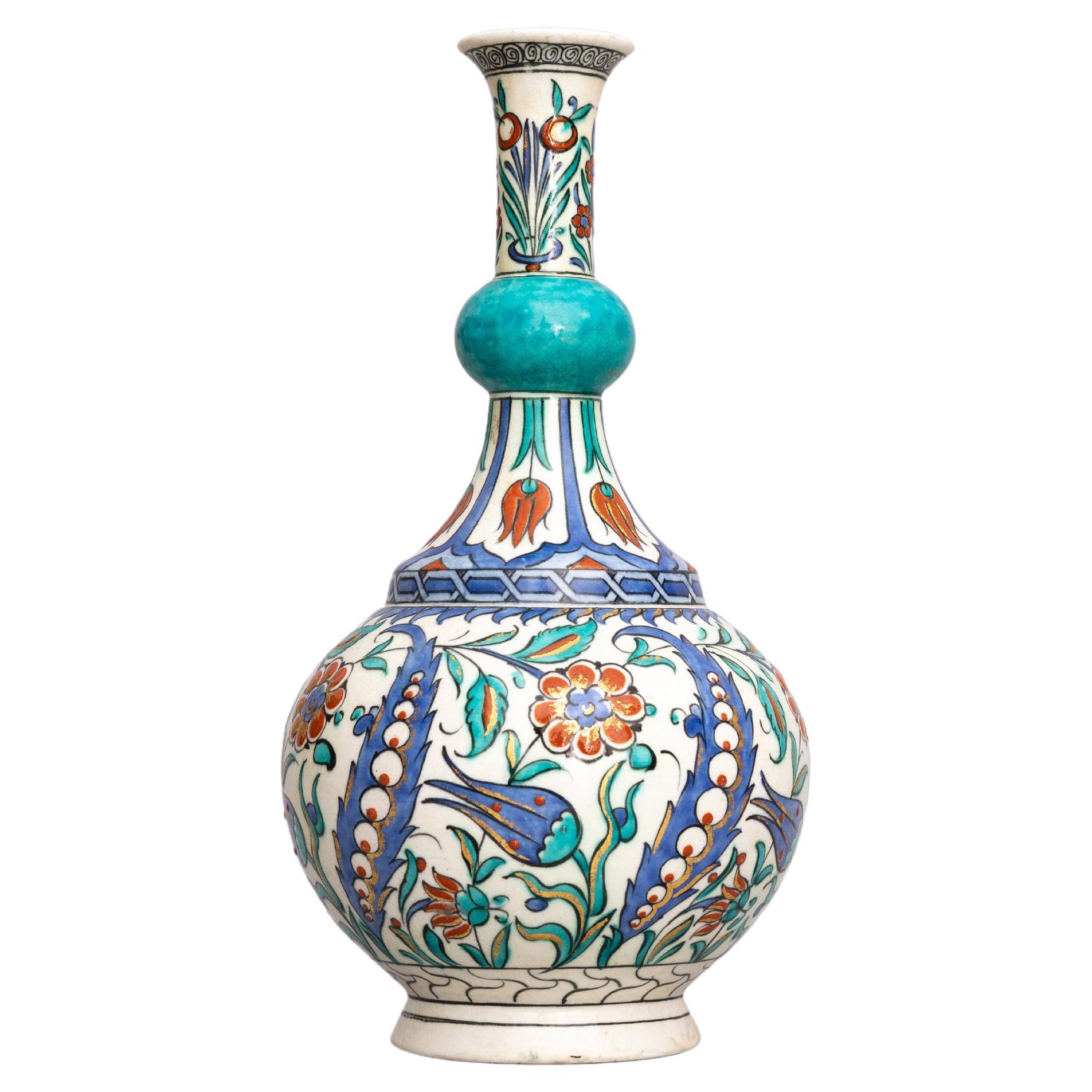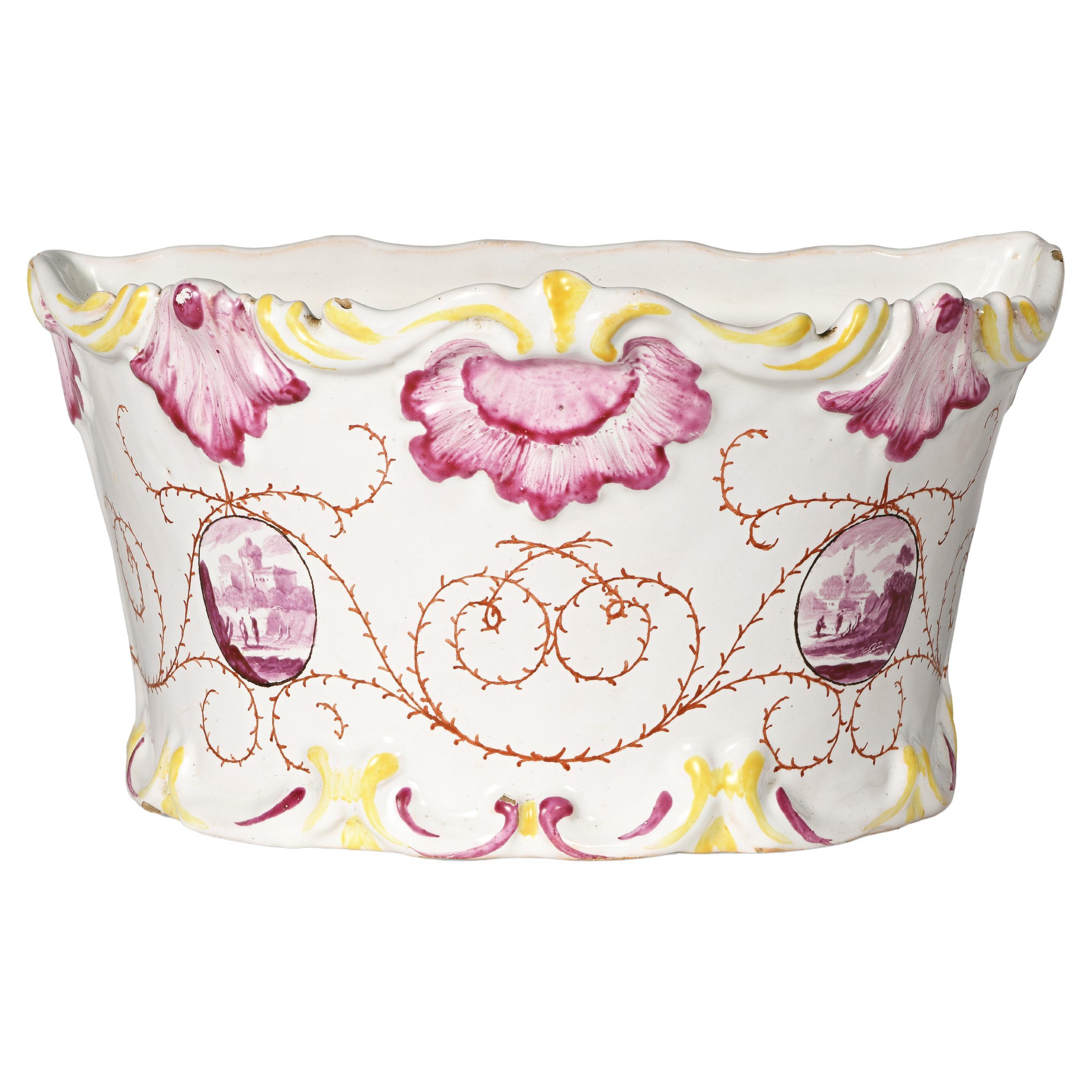Items Similar to Maiolica flower pots Samson & Fils Factory, France, late 19th century
Video Loading
Want more images or videos?
Request additional images or videos from the seller
1 of 21
Maiolica flower pots Samson & Fils Factory, France, late 19th century
About the Item
Maiolica flower pots “a mezzaluna”
Samson & Fils Factory
Montreuil-sous-Bois, France, late 19th century
They measure 4.72 in in height x 8.66 x 5.03 (12 cm x 22 x 12,8)
Weight: 1.88 lb each (856 g)
State of conservation: intact with slight chipping due to use in relief parts
A rare example of a flower pot “a mezzaluna” produced by the manufactory of Samson around the end of the 18th century. This is demonstrated by the small double S signature placed next to the writing “Sceaux” in italics under the base and flanked by the decorative number “5”.
The maiolica is decorated with a rocaille relief to adorn the edges. The upper part is perforated in a radial pattern to contain and support the flowers. This mold, which was also produced with a different morphology in France, is consistent with that used by the Milanese factories of the eighteenth century (for comparisons see the planters of the Castello Sforzesco Museum in Milan, R. Ausenda, a cura di, Musei e Gallerie di Milano. Museo d’Arti Applicate. Le ceramiche. Tomo secondo, Milano 2001, pp. 425, nn. 409 e n. 41).
The decoration shows, in the center of the vase, two bouquets which occupy the main part of the semicircle and which are accompanied by small bunches of rosebuds and minor florets rendered in full polychrome. The floral bouquets, in which the purple color predominates, stand out from the usual compositions since they resemble, in terms of decorative taste, the products of contemporary European porcelain manufactories, including that of Sceaux.
Careful observation of the vases, which bear, as mentioned above, the brand of the "Sceaux" manufacture, therefore reveals an inconsistency: the shape is typical of eighteenth-century manufactures in Milan, in particular that of Pasquale Rubati, but the main brand and the decoration are consistent with the works of French manufacturing. The explanation is provided by the presence of the small brand, associated with the previous one, in which the characteristic double "S" mark of the great nineteenth-century French ceramist Emile Samson (1837-1913) appears, certifying its paternity. Therefore, not only are the pair of maiolica flower pots the work of Samson, but they document the presence in his manufacture of 18th century Milanese works, which, as in this case, were mistaken for artefacts from the Sceaux factory. Another similar case among the Samson manufactory collections had already been recognized by scholars (R. Ausenda, op. cit, p. 326): a tureen similar to Milanese productions had been found.
The two flower pots therefore constitute a fixed point in the history of Emile Samson's manufacturing studies after 1891, attesting to the creative methods of his production lines and providing important information which identify his sources of inspiration.
The Samson "Porcelain, maiolica and terracotta factory" began its activity with Edmé Samson (1810-1891), a ceramic decorator, who opened his own factory in 1845 at number 7 rue Vendôme in Paris. His business lasted for four generations: their creations perfectly document the taste of the times, as well as demonstrate how much the attraction to the styles of previous periods - especially that of the 18th century - influenced the 19th and early 20th centuries. The factory was constantly busy and followed all sorts of clients. It produced ceramics ranging from maiolica and porcelain to earthenware, and in a variety of styles including that of the Renaissance and Spain, as well as Saxony and the Far East. Indeed, the production represents a perfect example of the advent of Historicism.
Emile (1837-1913) worked alongside and then succeeded his father Edmé, in making reproductions of old porcelains. These were all judged to be of excellent quality at the major exhibitions of the time, including the Universal Exhibition in Paris in 1867. It was also at that moment that the manufacture, which had become Samson & Cie, moved to Montreuil-sous-Bois, near Paris, and increased its production volumes. Further recognition came during the Universal Exhibition of 1889, especially thanks to the creation of large-scale works of both maiolica and porcelain: his models came from the largest French and foreign museums, such as the Louvre Museum or the Victoria & Albert Museum in London. Emile in 1891, with his son Léon (1868-1928), continued the business under the name of Samson & Fils, with great success and increased production. The activity then continued for other generations and with new perspectives until at least the 1980s.
Bibliography:
R. Ausenda, a cura di, Musei e Gallerie di Milano. Museo d’Arti Applicate. Le ceramiche. Tomo secondo, Milano 2001
F. Slitine, Samson, génie de l'imitation, Issy-les-Moulineaux 2002.
- Creator:Emile Samson (Maker)
- Dimensions:Height: 4.73 in (12 cm)Width: 8.67 in (22 cm)Depth: 5.04 in (12.8 cm)
- Sold As:Set of 2
- Style:Rococo (In the Style Of)
- Materials and Techniques:
- Place of Origin:
- Period:
- Date of Manufacture:Circa 1895
- Condition:Wear consistent with age and use. Intact with slight chipping due to use in relief parts.
- Seller Location:Milano, IT
- Reference Number:1stDibs: LU4352239225602
About the Seller
4.3
Vetted Seller
These experienced sellers undergo a comprehensive evaluation by our team of in-house experts.
Established in 1860
1stDibs seller since 2018
19 sales on 1stDibs
Typical response time: 1 hour
Associations
International Confederation of Art and Antique Dealers' Associations
- ShippingRetrieving quote...Ships From: Milano, Italy
- Return PolicyA return for this item may be initiated within 14 days of delivery.
More From This SellerView All
- Ancient Maiolica Flower Pot Pasquale Rubati Factory, Milan Circa 1770By Pasquale RubatiLocated in Milano, ITMaiolica flower pot “a mezzaluna” decorated with tulip Pasquale Rubati Factory Milan, circa 1770. Measures: 4.7 in x 4.7 in x 8.6 in 12 cm x 12...Category
Antique 1770s Italian Rococo Ceramics
MaterialsMaiolica
- Pair of Ancient Italian Maiolica Flower Pots Milan, Rubati Factory, 1770 circaBy Pasquale RubatiLocated in Milano, ITMaiolica flower pot “a mezzaluna” decorated with trompe l’oeil Pasquale Rubati Factory Milan, circa 1770 Measures: each 4.7 in (cm 12) x 5 in (c...Category
Antique 1770s Italian Rococo Ceramics
MaterialsMaiolica
- 18th Century, Italian Maiolica Flower Pot, Pasquale Rubati, Milan, 1770 circaBy Pasquale RubatiLocated in Milano, ITMaiolica flower pot “a mezzaluna” decorated with trompe l’oeil Pasquale Rubati Factory Milan, 1770 circa It measures: 4.7 in (cm 12) X 5 in (...Category
Antique 1770s Italian Rococo Ceramics
MaterialsMaiolica
- Italian Maiolica Flower Pot Garlands of Flowers, P. Rubati, Milano, 1770 circaBy Pasquale RubatiLocated in Milano, ITMaiolica flower pot “a mezzaluna” decorated with garlands of flowers Pasquale Rubati Factory Milan, circa 1770 Measures: 4.7 in x 5 in x 8.8 in ...Category
Antique 1770s Italian Rococo Ceramics
MaterialsMaiolica
- Rococo Italian Maiolica Flower Pot Pasquale Rubati, Milano, 1770 circaBy Pasquale RubatiLocated in Milano, ITMaiolica flower pot “a mezzaluna” with support feet decorated with little bunches of flowers Pasquale Rubati Factory Milan, circa 1770 5.5 in X ...Category
Antique 1770s Italian Rococo Ceramics
MaterialsMaiolica
- Small Maiolica Flower Pots, Ferretti Manufacture, Lodi, circa 1770-1780By Antonio FerrettiLocated in Milano, ITTwo maiolica flower pots Antonio Ferretti Manufacture Lodi, Circa 1770 - 1780 Maiolica polychrome decorated “a piccolo fuoco” (third fire) The...Category
Antique 1770s Italian Rococo Ceramics
MaterialsMaiolica
You May Also Like
- French Late 19th Century Large Brass PotLocated in Baton Rouge, LAA sizable vessel, made in France circa 1880 of solid brass. The pot has a large iron handle for carrying or hanging it. It will lay flat when not being used. Over the years, the bras...Category
Antique 19th Century French Other Urns
MaterialsBrass
- Late 19th Century French Terracotta Confit PotLocated in Winter Park, FLA large earthenware confit pot from the Southwest of France with traditional yellow, ochre glaze. One of the tallest I have ever seen at 14" high. Some chips and hairline and losses ...Category
Antique Late 19th Century European French Provincial Pottery
MaterialsTerracotta
- Late 19th-Century Iznik-Style Vase by SamsonBy Edmé SamsonLocated in Fort Lauderdale, FLAn Iznik-style vase made by Edmé Samson et Cie after a 16th-century Turkish bottle vase in the collection of the Musée d'Ecouen. The vase’s bulbous body is decorated in a red, cobalt blue, turquoise, and green floral design of saz leaves, roses, and tulips. The neck is decorated with delicate floral sprays. The design is highlighted with gilding throughout, and is intentionally sparse around the turquoise area of the neck to mimic the wear of the 16th-century vase after which it was modelled. As with many other Samson Iznik...Category
Antique Late 19th Century British Islamic Vases
MaterialsCeramic, Porcelain
- Antique 19th Century Italian Maiolica Pot of the Renaissance StyleLocated in Dallas, TXVivid colors, hand-painted in the Renaissance style, enhance this large maiolica pot from the 1800’s. Maiolica is tin-glazed pottery from Italy that has been decorated over a white background. This pot is considered an istoriato, which is to say that the pot has been decorated with figures, rather than strictly geometric patterns or floral designs. The maiolica does incorporate floral and foliate motifs, with white flowers that have yellow centers surrounded by blue rings. There are also yellow flowers that are depicted in various stages of nyctinasty (the closing of flowers during the night). The flora is all connected by a series of green and yellow curled leaves. Behind the vegetation is a dark blue background. There are two portraits inside large yellow cartouches that are painted in the middle of the pot. The first is a bearded man, dressed in a light brown tunic...Category
Antique 19th Century Italian Renaissance Vases
MaterialsMaiolica
- Large Earthenware Pot, late 19th CenturyLocated in South Salem, NYThis four-handled earthenware pot is a captivating piece that exudes both rustic charm and functionality. Crafted with skill and attention to detail, it showcases the timeless beauty...Category
Antique Late 19th Century French French Provincial Urns
MaterialsEarthenware
- Late 19th Century Terra Cotta PotLocated in Charlottesville, VASimple pot, inside or outside. Made in the Late 19th CenturyCategory
Antique Late 19th Century Italian Jars
MaterialsTerracotta
Recently Viewed
View AllMore Ways To Browse
Antique Factory
French Factory
French Flower Stand
Late Eighteenth Century
Eighteenth Century French
Antique French Documents
Antique Produce Scales
Factory Mold
Old Antique Flower Vase
Vase Foreign
Antique Flower Vase Antiques
1895 French Vase
Eighteenth Century French Furniture
Antique Old Paris Vases
Large Contemporary Pots
French Vendome
French Antique Furniture Reproduction
French Antique Reproduction Furniture

